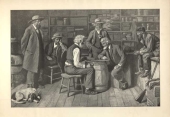The Checker Maven
The World's Most Widely Read Checkers and Draughts Publication
Bob Newell, Editor-in-Chief
Published each Saturday morning in Honolulu, Hawai`i
Contests in Progress:
Theory of Fun
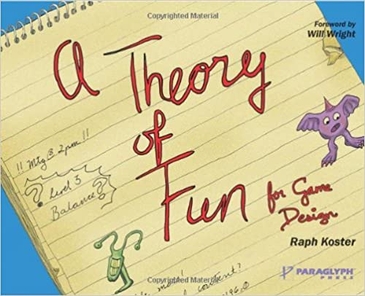
There's an interesting book titled A Theory of Fun for Game Design by Raph Koster, published in 2004. The book touches on some valid points about how games are designed and ultimately played. However, when it comes to our game of checkers, Mr. Koster says the following.
"Until now, I've been discussing formal game design--- abstract simulations. But we reely see truly abstract simulations in games. People tend to dress up game systems with some fiction. Designers put artwork on them that is suggestive of some real-world context. Take checkers for example--- abstractly it's a board game about entrapment and forced action, played on a diamond-shaped grid. When we say "king me" in checkers, we're adding a subtle bit of fiction to the game; suddenly it has acquired feudal overtones and a medieval context. Usually, the pieces have a crown embossed on them."
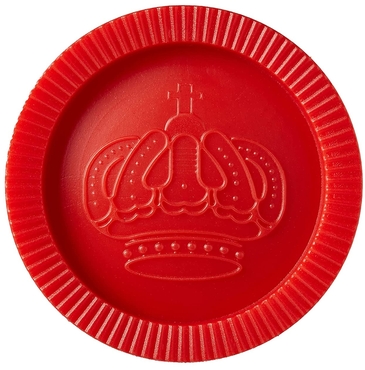
We don't have enough space in this column to discuss all of Mr. Koster's errors and misconceptions; suffice it to say that he seems to have little or no knowledge of checkers played as a serious game. However, we did get genuine amusement from the idea of "feudal overtones" related to the process of crowning a piece. We wonder if, as a potential player, he would also subscribe to the common erroneous advice to "always keep your king-row intact."
So, for today's checker problem, let's use our collective imagination. Think of the kings as bearing jeweled crowns and dressed in the finest of purple robes. Think of the men as clad in leather armor and metal helmets, bearing swords, axes, and pikes. Think of the checkerboard as the field of battle, perhaps in ancient Carthage (ancient rather than medieval, but still quite colorful). Listen to the call of trumpets, the beat of drums, the battle cries of the massed warriors.
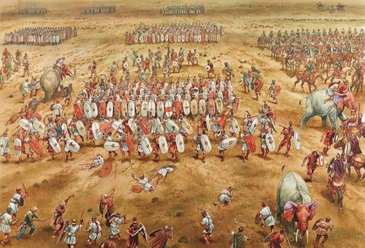
Or maybe not. Perhaps you'd just like to solve a good checker problem without a lot of distracting imagery. It's up to you. Was Mr. Koster correct or incorrect with his medieval contexts and feudal overtones? Does it really matter?
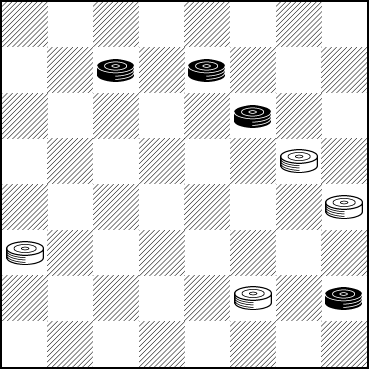
WHITE
White to Play and Draw
W:W16,20,21,27:B6,7,11,28
See how you do with this one and then click on (or march over to, if you will) Read More to view the solution.![]()
Draughts Down Under

Australians Bob and Norma Meadley come from the very small town of Narromine in New South Wales, where Bob pursues his hobby of draughts (checkers) and Norma volunteers at the local library. "Narromine" doesn't refer to a "narrow mine," as you might think, but instead is derived from a word in a native Australian language which means "honey people."

The Meadleys have sent us a most unusual book, you might say a honey of a book, with permission to distribute it gratis to the checker community. It's a book they've worked on for quite a long while, pulling together a rambling, eclectic combination of materials ranging from articles on the history of checkers (draughts) to rare newspaper clippings and photos and documentation of James "The Herd Laddie" Wyllie's visit to Australia and New Zealand.

Bob Meadley
Mr. Meadley sent me the following fascinating notes about the book's cover (shown above):
"Now a little bit of history about that old board. When I was in my mid 20s I went over to the grand old man of Australian Chess Problems and he was only 3 years away from dying in 1968. He gave me the board which consists of timber strips held together by canvas cloth. It dates to the late 19th century from when he was a young man (born 1880) and played chess in rural NSW. The patina is untouched but I did have to reglue some new canvas on one rotted part. The three boxes of draughts men (left; all black and white) are 'Dreadnaught Products'; 'The National Games Draught Men' (right); an unnamed set on a fine board just called 'Draughts'(middle); and finally 'Marquis Plastic Moulded Draughtsmen' (2nd row left). The scattered red and black men are mine from my teenage years where we played in the railway workshops."
The book is lovingly assembled and runs to more than 300 pages. It will provide hours of checker entertainment and amazing insights and information. You can get it here.
Of course no Checker Maven column is complete without a checker problem, and so we've selected this one from the book.
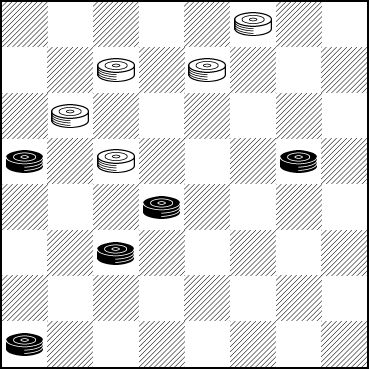
BLACK
Black to Play and Draw
B:W19,24,26,27,30:B4,11,15,17,20
You'll find this on page 143 of the book, but alas, without solution. Is this a "honey" of a problem? See what you think by trying to solve it, but it's a sweet thing to realize that clicking on Read More will show you the winning way.![]()
Checker Games of James Ferrie
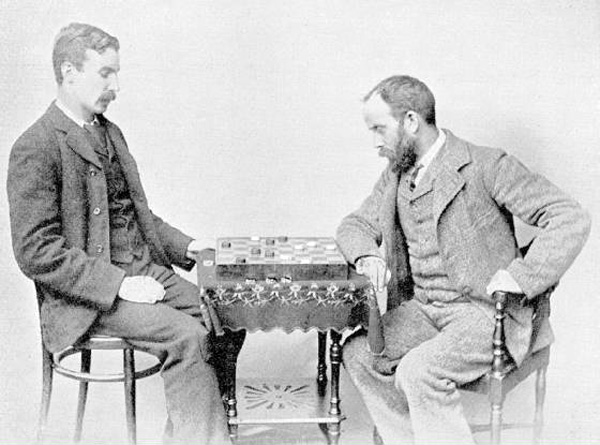
No, you're not seeing double, and this is not a repeat article. You did see a version of the above picture a few weeks back when we featured Jim Loy's book on Robert Jordan. Today we're featuring the other half of the picture, as we bring you Jim Loy's book, The Best Checker Games of James Ferrie.
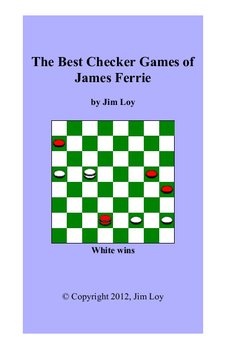
In 1894 Ferrie took the title of World Champion from the legendary James Wyllie, holding it until 1896 when Robert Jordan won it. Ferrie played many brilliant and instructive games, and Jim Loy has gathered them together, annotated them extensively, and provided numerous diagrams. Download the book here or from the Jim Loy page linked in the right side panel.
The position above, on the cover of the book, comes from the 1896 Scottish tournament. Here it is again in our usual format.
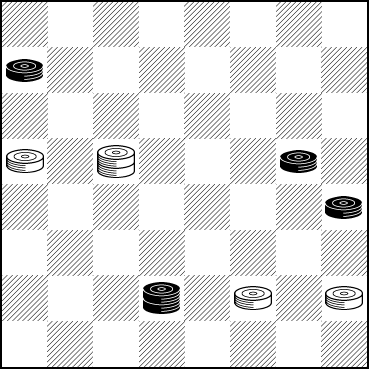
WHITE
White to Play and Win
W:W13,K14,27,28:B5,16,20,K26
See if you can find the win, then download the book and go to Game 101 to see how it played out. The Checker Maven thanks Mr. Loy for providing yet another of his fine publications for cost-free download.![]()
The Composition of Stroke Problems
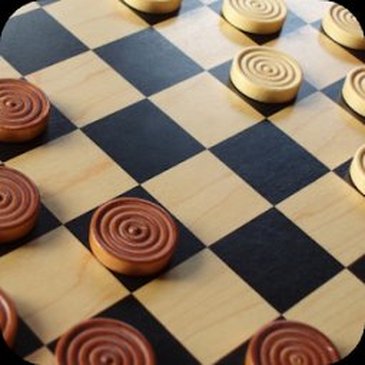
Today we have yet another fascinating checker book to offer to our readers, thanks to a gentleman from Michigan who only wishes to be credited as "A Checker Friend."
The book is the A. C. Hews classic, The Composition of Stroke Problems, extracted from Hews' 1917 classic Stroke Problems. This new edition is fully illustrated with 81 diagrams added by our Checker Friend. There's also a file with PDN notation for each position. It's a treasure trove for fans of the genre.
We know that stroke problems are not for everyone. But this little book gives us great insights into how stroke problem composers go about their business, and if you're a budding stroke problem composer, we're sure you'll find this book a useful stepping stone in your pursuit of this unusual and often spectacular art.
Just for fun, here's one of the positions from the book.
BLACK
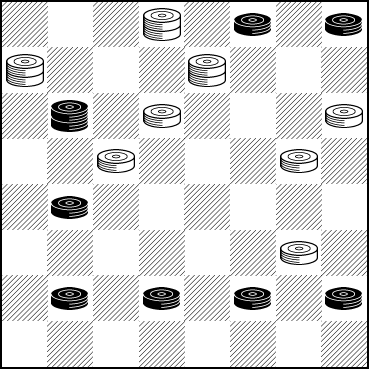
WHITE
White to Play and Win
W:WK2,K5,K7,10,12,14,16,24:B3,4,K9,17,25,26,27,28
Mr Hews' idea of "easy" may not agree with yours--- or ours! But see if you can solve it without touching the pieces; it's great visualization practice. Then download the book here and look up the solution.![]()
Richard Jordan: A Jim Loy Book
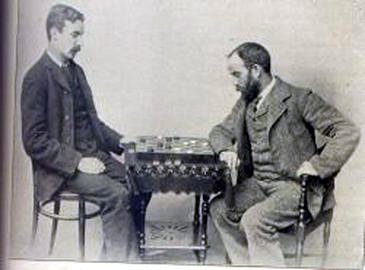
Jordan-Ferrie Match
Today we're pleased to present another of Jim Loy's books, this one in his developing series on the greatest checker players of past years. Jim's subject in this book is the great Edinburgh player Richard Jordan (not to be confused with another great, Alfred Jordan).
Richard Jordan only lived to age 39, his life cut short by a tragic accident. But in that time he played great checkers, including once having defeated the legendary James Wyllie.
The following position is from the cover of Mr. Loy's book. It's from the 1897 World Championship Match played by Mr. Jordan against R. Stewart, yet another luminary from the legendary age of checkers.

WHITE (R. Jordan)
White to Play and Win
W:W10,13,14,15,19,23,25,27,31,32:B1,3,5,6,8,12,16,18,20
Match wits with Richard Jordan and find the win. When you're satisfied with your solution, do one of two things. Either download the book here to see how the game actually went, or click on Read More to see a computer solution.![]()
Complete Checkers: Insights
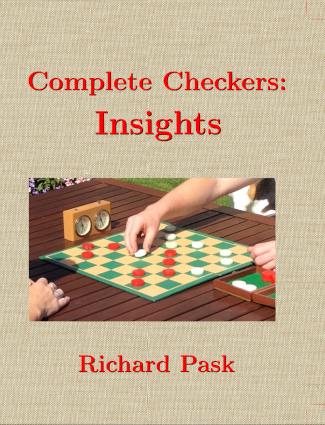
Today marks a milestone in the history of checker publications as we announce the release of Grandmaster Richard Pask's monumental Complete Checkers: Insights.
Insights contains in one volume the newly edited and revised series of five books originally published electronically as the Logical Checkers series. Insights is available as a completely free PDF download or as a modestly priced print book, available from Amazon US as well as other Amazon sites worldwide. The print book is an 8" x 10" trade paperback, 630 pages, double column, with 1,024 diagrams comprising 366 lessons.
Insights provides everything the student needs to go from complete novice to accomplished expert, fully prepared for master level studies. We believe there has never been a checker book like this one in the entire history of the game.
We further contemplate the release of Complete Checkers: Repertoire as a companion volume in the same format at some point in 2022. Repertoire will be an edited reissue of the original Complete Checkers, 3rd Edition.
But for now you can download Insights here, or from the Richard Pask page linked in the right-hand column. Please do consider ordering a print copy if your means and desires so permit, as it will help us to recover the costs of producing this volume.
As always our thanks go out to Grandmaster Pask for his hard work and great generosity.
Here's a position from the book, credited to one H. Byars. Can you solve it? Give it a try and download or buy the book to see the solution.
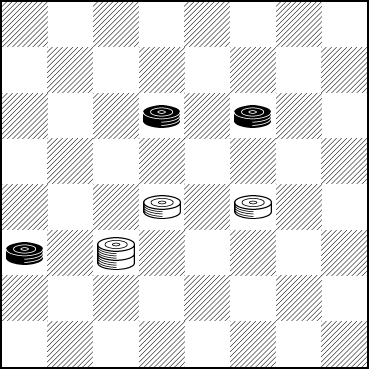
WHITE
White to Play and Win
W:W18,19,K22:B10,11,21
The solution is found under Diagram 872 on page 474.![]()
English Open 2013
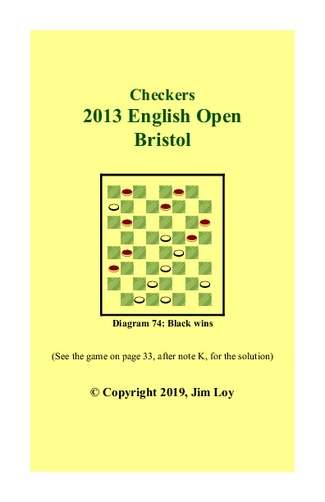
The 2013 English Open 3-Move Championship took place in the city of Bristol from April 22 through April 26 of that year. By any account it was a memorable tournament featuring some fine play. The tournament was won by one of the younger competitors, Shane McCosker. Referred to by Alex Moiseyev as an up and coming player on the world stage, this was hardly Shane's first tournament win. He has taken first place in numerous other tournaments prior to the 2013 contest, including the American Youth Tournament in 2007. He has won many more since 2013.
(The Checker Maven regrets being unable to obtain higher quality photographic images from the Bristol tournament.)
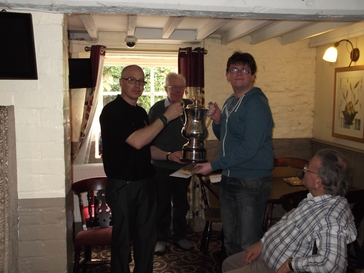
Shane McCosker (right, standing)
Second place went to Francis McNally.
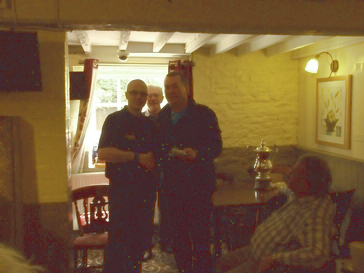
Francis McNally (right, standing)
Third place was taken by Colin Young.
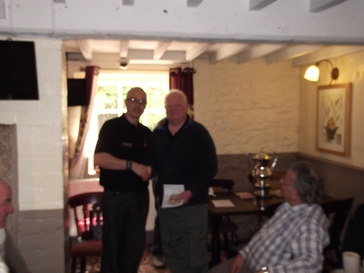
Colin Young (right, standing)
Eminent checker author, analyst, and annotator Jim Loy assembled a book containing a large number of the tournament's games, and added his own notes and analysis as well as many diagrams, set up as problems to be solved. The book is highly instructive, and Mr. Loy is kindly offering it to Checker Maven readers as a free download. It's absolutely worth having and you can get it here.
So how about that problem position shown on the cover of the book?
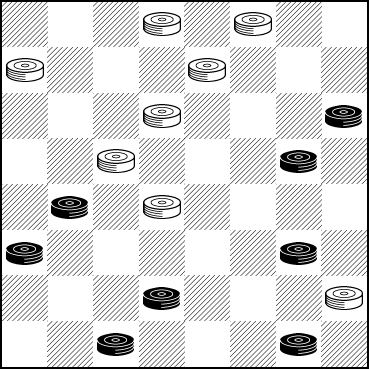
BLACK
Black to Play and Win
B:W5,15,19,23,26,28,30,31:B1,3,7,9,12,16,17,21
See how you do with this one. Of course it's best to download the book, but you can also check your solution by clicking on Read More. Thank you, Jim Loy, for this excellent book.![]()
Logical Checkers Volume 5
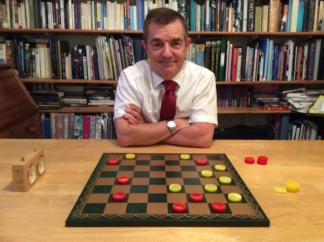
Grandmaster Richard Pask
It's here! Grandmaster Richard Pask's fifth and concluding volume of his Logical Checkers series is now available for free download here, or from the Richard Pask page as linked in the right-hand column. (Earlier download problems have been resolved.)
Over 300 pages in length and filled with diagrams, the book provides the crowning touch to this unprecedented series of instructional volumes, designed to take the player from novice to expert, fully prepared for master level studies.
As a sample of the new book's content, here's an illustrative game leading to a problem position, with Mr. Pask's commentary.
Illustrative Game 150: 9-13 24-20; 10-14 22-18; 5-9 27-24; 6-10 25-22; 1-5?! (although impossible to criticize in general terms, analysis has shown that this should be avoided, with 10-15! preferred) 31-27!; 14-17 (10-15? 23-19; 14-23 27-18!; 7-10 26-23; 3-7 30-25 is a quick win scored by Pat McCarthy over Ken Lovell) 21-14; 10-17 29-25; 17-21 18-14; 9-18 23-14; 11-15 27-23; 8-11? White to Play and Win.
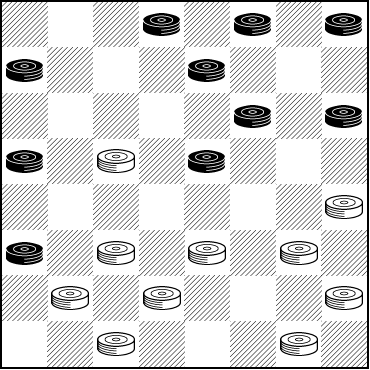
WHITE
White to Play and Win
W:W14,20,22,23,24,25,26,28,30,32:B2,3,4,5,7,11,12,13,15,21
15-18 and the resultant 3 for 3 would have drawn. Can you find the White win? Of course, as would be expected in an advanced study, you may not find it easy. For the solution, download the book and refer to page 167.
Now that this landmark series is concluded, we plan to prepare and publish a comprehensive single-volume edition of all five parts of Logical Checkers, a mammoth book with over 1,000 diagrams and likely running above 800 pages. An electronic version will as always be provided completely free of charge. The trade paperback print edition is estimated to cost around $30.00, although that has yet to be finalized. The book will take quite some time to bring to press, but look for it in the latter part of 2021.
The Checker Maven thanks Grandmaster Pask for the honor of continuing to publish his work and for his unparalleled generosity in providing it to the checker playing public completely free of charge.![]()
Logical Checkers Volume Four

It's here! The fourth volume of Richard Pask's projected five-volume Logical Checkers series, entitled Checkers for the Three-Move Expert: Balanced Ballots is available to download in PDF format here or from the "Richard Pask" page as linked in the right-hand column. Of course, the book is completely free of charge, as are all the ebooks in the series.
Volume Four provides in-depth coverage of selected endgames, advanced tactics, mid-game landings, and of course balanced three-move ballots. The book is over 200 pages in length, with many examples, illustrative games, and diagrams.
Looking forward, we anticipate seeing Volume Five as early as the end of 2020, with a mammoth print volume of the whole series projected for later on in 2021.
Our thanks go to Grandmaster Pask for the opportunity to publish his works, and for his generosity in providing them gratis to the world-wide checker-playing community.
As a teaser, here's a position found in the book.
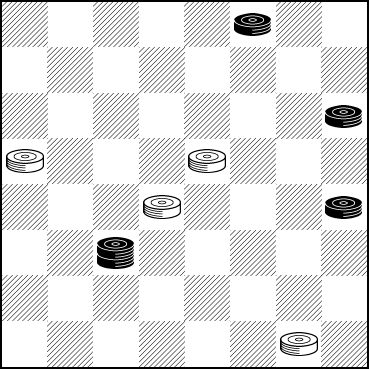
WHITE
White to Play, What Result?
W:W13,15,18,32:B3,12,20,K22
For the solution, see page 123 of Richard's new book.![]()
Checker Jargon

It seems that an obsession with jargon has dominated the business world during the past few decades. There's "rightsizing," "synergy," "proactivity," and thousands more, and it seems that such terms offer very little other than a way to take up screen space in yet another stultifying PowerPoint presentation.
In today's Checker School entry, our friends Skittle and Nemo return. You'll recall that they are to be found in Andrew J. Banks' fascinating book, Checker Board Strategy. Let's listen in as Skittle instructs Nemo. Note that Skittle prefers the word "vocabulary" over "jargon."
"As we solve problems," Skittle suggested to Nemo, "let's use the checker vocabulary. When you jump two pieces, call it a 'Two-Shot.'"
"Why get technical?" protested Nemo. "Solutions flash on me. Checkers is the silent game."
This raises an interesting question: Just how much does 'checker jargon' such as "Two-Shot", "Breeches," and all the rest, add to our learning and understanding? We'd posit that when a name reinforces the idea concerned, it's useful. A "breeches" position is easy to picture and easy to remember. A "Two-Shot" is just as clear. But the names of openings, for instance, while providing a convenient shorthand, don't really tell us much in and of themselves.
Mr. Banks uses the following position as an illustration. Can you solve it--- and come up with some "checker jargon" to describe the solution?
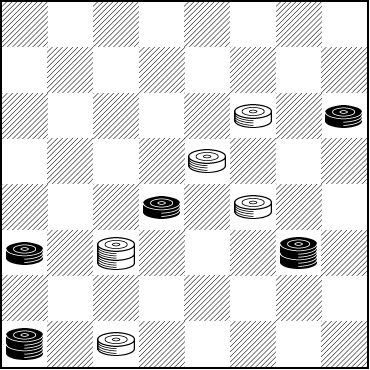
WHITE
White to Play and Win
W:W11,15,19,K22,30:B12,18,21,K24,K29
You won't be able to merely talk your way through this one, and we don't know if the solution will "flash" on you, but we won't insist that you solve it silently. Do however give it a try. It's not especially difficult. Flash your mouse on Read More when you're ready to see the solution.![]()
The Checker Maven is produced at editorial offices in Honolulu, Hawai`i, as a completely non-commercial public service from which no profit is obtained or sought. Original material is Copyright © 2004-2025 Avi Gobbler Publishing. Other material is the property of the respective owners. Information presented on this site is offered as-is, at no cost, and bears no express or implied warranty as to accuracy or usability. You agree that you use such information entirely at your own risk. No liabilities of any kind under any legal theory whatsoever are accepted. The Checker Maven is dedicated to the memory of Mr. Bob Newell, Sr.

